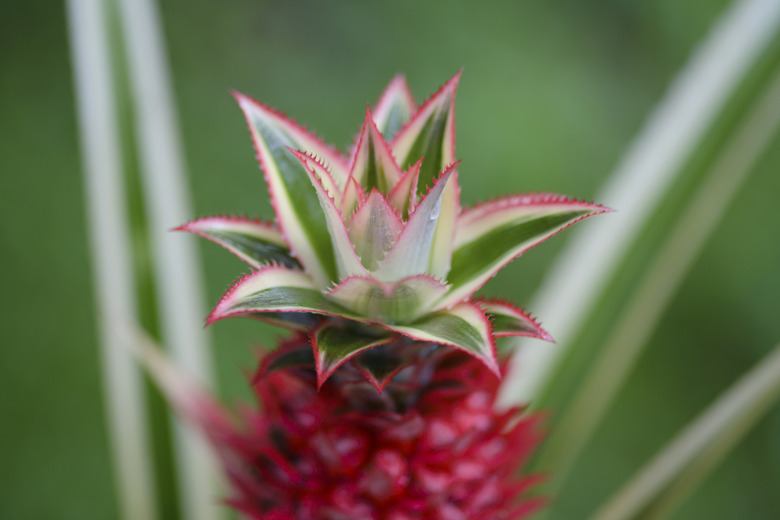How To Care For A Pineapple Plant
Sun, warmth, a little water and regular fertilizer are all it takes to care for a pineapple plant (Ananas comosus), both for the ornamental spiky leaves and the fruits. In U.S. Department of Agriculture plant hardiness zones 10 through 11, you can grow this tropical plant outdoors year-round. In all other zones, grow it in a pot you take outside for the summer and bring in for winter. A pineapple plant is happiest at around 68 degrees Fahrenheit.
Watering Indoors and Out
Water pineapple plants in containers and in the ground once a week. Allow the potting mix in pots to dry out 2 to 3 inches deep between waterings. Water the pots thoroughly, making sure it penetrates through to the bottom. When you've watered a potted pineapple enough, you'll see water leaking from the bottom of the pot. If the pot has a drip tray, empty it after watering. Make sure the pot has a hole in the bottom for drainage. Outdoors, water when the top 1 to 2 inches of soil feel dry, soaking the soil 3 to 4 inches deep.
Regular Fertilizer
Once a month, fertilize a pineapple plant with abalanced fertilizer. Use 1/2 tablespoon of a 10-10-10 slow-release formula for a potted pineapple sprinkled onto the soil. Gently work it 1/2 inch deep in the soil.
Outdoors, use 1/3 cup of 10-10-10 fertilizer for each plant. For larger plantings, use 2/3 cups for each 5- by 5-foot area. Spread the fertilizer evenly on the soil around the roots, then mix it into the top 1 inch of soil.
Water after fertilizing for both potted and in-ground pineapple plants. Soak the soil in the container until it is moist through to the bottom. Outdoors, water until the top 3 to 4 inches of the soil are moist.
Pest Problems
A pineapple plant is usually disease-free but that doesn't make it problem-free. Pests that attack both indoor and outdoor plants include mealybugs, mites and scale insects. Mealybugs are white, fluffy insects that tend to feed at joints where the leaves meet. Mites are minuscule, pale pests that feed on the leaves. Scales look like hard lumps on the leaves but dislodge easily when you scratch them with a fingernail.
Dealing With Pests
Use water as your first line of defense, spraying the insects with a strong jet to dislodge them. Another method is to hand pick mealybugs and scale insects from the leaves, or use a damp paper towel to wipe off mites. Use cotton swabs to reach down between the leaves on a pineapple.
When manual removal fails, spray mealybugs, mites and scale with ready-to-use insecticidal soap making sure to saturate the pests themselves as these products work on contact. Insecticidal soaps are generally suitable for both indoor and outdoor plants. Repeat after seven days or according to the label's instructions. Follow the label instructions as they may vary by brand.
Yellowing Leaves
Yellowing or browning leaves indicate one of several problems on a pineapple plant. Overwatering, which can cause root rot, is common, especially in containers. Brush the soil away from the roots and look for mushy, brown roots. Allow the soil to dry out and look for signs of new growth. Once root rot sets in, a pineapple plant has only a slim chance of survival.
Drought also causes yellowing and browning leaves, beginning with the older outside leaves. Soak garden soil slowly until it is damp 6 inches deep and water a pineapple in a pot until water leaks out the drain holes.
Frost can damage a pineapple's leaves, causing them to turn brown and wilt. Sterilize a garden knife in a solution of 3 parts water and 1 part bleach, soaking the blade for five minutes. Rinse it, dry it, then use it to cut the damaged leaves near the base of the pineapple plant.
